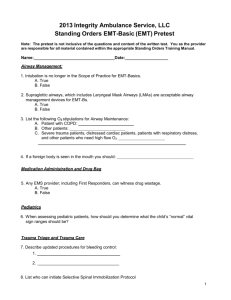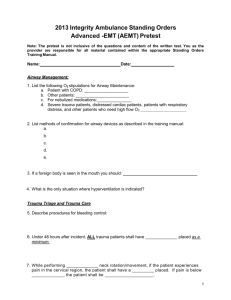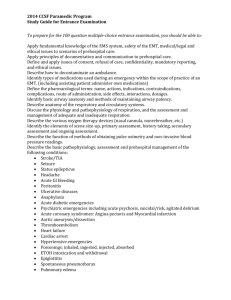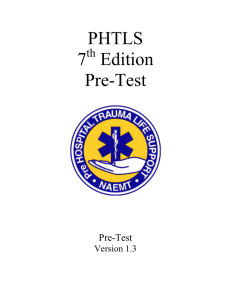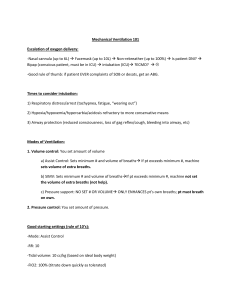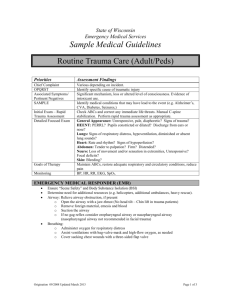phtls pretest
advertisement
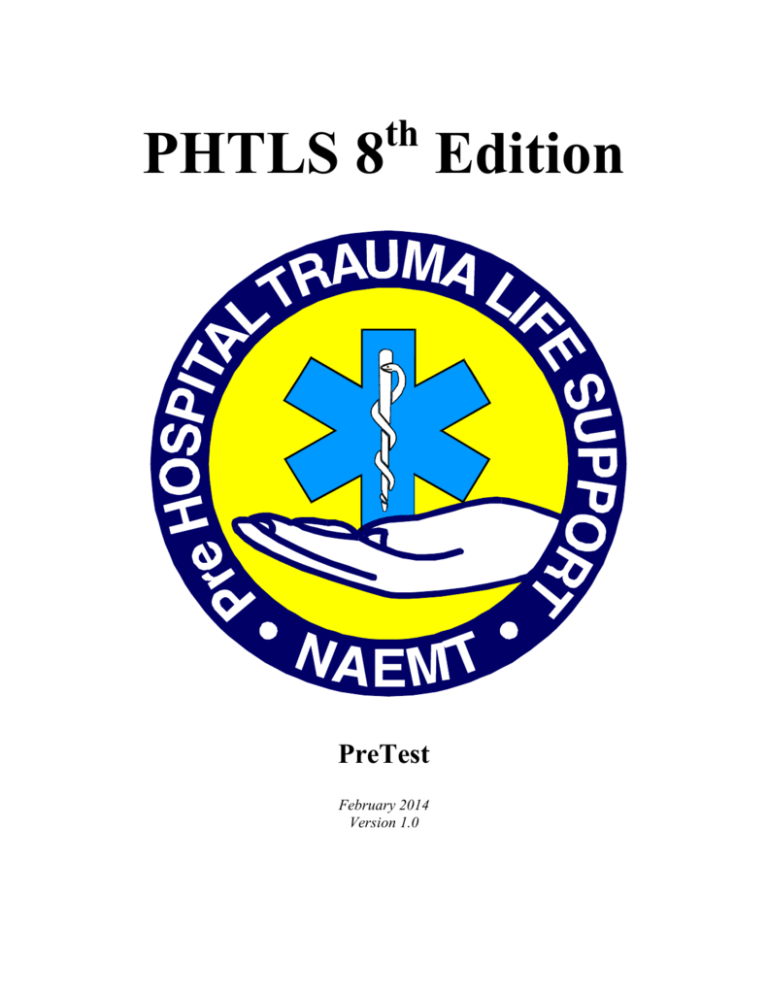
th PHTLS 8 Edition PreTest February 2014 Version 1.0 Pre-Hospital Trauma Life Support Provider Program Pre-Course Written Evaluation Answer Sheet Name: Course Number: __ Date: 1) A B C D 16) A B C D 2) A B C D 17) A B C D 3) A B C D 18) A B C D 4) A B C D 19) A B C D 5) A B C D 20) A B C D 6) A B C D 21) A B C D 7) A B C D 22) A B C D 8) A B C D 23) A B C D 9) A B C D 24) A B C D 10) A B C D 25) A B C D 11) A B C D 12) A B C D 13) A B C D 14) A B C D 15) A B C D DO NOT MARK IN THIS EXAMINATION BOOKLET. USE THE PROVIDED ANSWER SHEET. PHTLS PRETEST Please respond to each question with the most correct answer from the given choices. There is only one answer for each question. 1) You arrive at the scene of a motor vehicle collision in which a vehicle struck a tree. Which is the best indicator of potential injury? A) B) C) D) 2) The potential for death or serious injury is greatest in which of the following motor vehicle collisions? A) B) C) D) 3) Angular impact Bike-road impact Head-on impact Rear impact Which is the preferred fluid for resuscitation of hemorrhagic shock in the prehospital setting? A) B) C) D) 5) Down and under Ejection from vehicle Lateral compression Up and over Bilateral femur fractures are most often associated with which type of motorcycle crash? A) B) C) D) 4) Circumference of the vehicle Diameter of the tree Mass of the vehicle Speed of the vehicle 5% dextrose in water 7.5% hypertonic saline Hetastarch Lactated Ringer’s Which is the most common cause of upper airway obstruction in the trauma patient? A) B) C) D) Blood Teeth Tongue Vomitus February 2014 8th Edition Version 1.0 Participant Copy 1 DO NOT MARK IN THIS EXAMINATION BOOKLET. USE THE PROVIDED ANSWER SHEET. 6) Which is the preferred adjunct device for verifying placement of an endotracheal tube in a patient with a perfusing rhythm? A) B) C) D) 7) Which is the most important reason to maintain an open airway in the trauma patient? A) B) C) D) 8) Dual lumen airway Endotracheal intubation Laryngeal mask airway Oropharyngeal airway Your patient is a middle aged male who crashed his motorcycle. He is unresponsive. After opening the airway using a modified jaw thrust, you note the patient has respirations at a rate of 6. Auscultation reveals breath sounds are absent on the left side. Which of the following is the most appropriate next intervention? A) B) C) D) 10) Prevents aspiration and pneumonia Prevents hypoxemia and hypercarbia Prevents snoring respirations Prevents the tongue from blocking the pharynx Essential airway skills include manual clearing of the airway, manual maneuvers, suctioning and which of the following? A) B) C) D) 9) End-tidal CO 2 monitoring (capnography) Esophageal detector device Pulse oximeter Stethoscope Apply a non-rebreather mask Begin ventilation with a BVM Insert an endotracheal tube Perform a needle decompression Which best describes shock? A) B) C) D) Decreased Glasgow Coma Scale (GCS) Flushed, dry, hot skin combined with bradycardia Generalized inadequate tissue perfusion Low blood pressure combined with tachycardia February 2014 8th Edition Version 1.0 Participant Copy 2 DO NOT MARK IN THIS EXAMINATION BOOKLET. USE THE PROVIDED ANSWER SHEET. 11) Your patient has a deep laceration to his antecubital fossa with significant bleeding. What is the most appropriate initial action? A) B) C) D) 12) Hypotension of unknown etiology in a trauma patient should be assumed to result from which of the following? A) B) C) D) 13) Abdomen Blood pressure Neurologic status Skin The body initially compensates for blood loss through activation of which of the following? A) B) C) D) 15) Blood loss Cardiac tamponade Spinal injury Tension pneumothorax Which assessment is most beneficial in differentiating hemorrhagic shock from neurogenic shock in the prehospital setting? A) B) C) D) 14) Apply a tourniquet Apply direct pressure Initiate rapid transport Restore blood volume Parasympathetic nervous system Reticular activating system Spinal reflex arcs Sympathetic nervous system Medication used by trauma patients for pre-existing conditions may cause which of the following? A) B) C) D) Herbal preparations may enhance blood clotting Anti-inflammatory agents may enhance blood clotting Beta blockers may prevent tachycardia with blood loss Calcium channel blockers may slow the onset of shock February 2014 8th Edition Version 1.0 Participant Copy 3 DO NOT MARK IN THIS EXAMINATION BOOKLET. USE THE PROVIDED ANSWER SHEET. 16) The target blood pressure for a trauma patient with suspected intraabdominal hemorrhage is which of the following? A) B) C) D) 17) Which best explains the mechanism by which gas exchange is impaired in pulmonary contusion? A) B) C) D) 18) Blood in the alveoli Collapse of the alveoli Compression of the lung tissue Partial occlusion of the bronchi Which of the following is a key finding that differentiates cardiac tamponade from tension pneumothorax? A) B) C) D) 19) 60 – 70mm Hg 80 – 90 mm Hg 100 – 110 mm Hg 120 – 130 mm Hg Distended jugular veins Equal breath sounds Hypotension Tachycardia Your patient is a 20 year old male who struck his head on a teammate’s knee while diving to catch a football. He was not wearing a helmet. He demonstrates decerebrate posturing and has a GCS score of 4. His heart rate is 58, blood pressure 180/102 and his left pupil is dilated. What is the best ventilation rate to use when managing this patient? A) B) C) D) 10 breaths per minute. 20 breaths per minute. 30 breaths per minute. 35 breaths per minute. February 2014 8th Edition Version 1.0 Participant Copy 4 DO NOT MARK IN THIS EXAMINATION BOOKLET. USE THE PROVIDED ANSWER SHEET. 20) A 20 year old female was ejected from her vehicle during a high speed roll-over motor vehicle collision. She has significant bleeding from a large laceration. Your initial assessment reveals a GCS score of 7, systolic blood pressure of 70 mm Hg and pupils that are equal but respond sluggishly to light. After establishing two large bore IV lines, you should titrate the infusion rate to achieve a target blood pressure of at least A) B) C) D) 21) Which of the following is the preferred prehospital wound management for a patient with a 36% body surface area flame burn? A) B) C) D) 22) Cool moist dressings Dry sterile dressings Elastic bandages Topical ointments The most immediate life threatening condition resulting from injury to solid abdominal organs is which of the following? A) B) C) D) 23) 60 mm Hg. 70 mm Hg. 80 mm Hg. 90 mm Hg. Acute respiratory failure Hemorrhage. Multiple organ failure. Peritonitis An adult male sustained a deep laceration to his distal thigh. Bright red blood is spurting from the wound. Direct pressure is not controlling the bleeding. What is the most appropriate next step? A) B) C) D) Apply a topical hemostatic agent and transport Apply a tourniquet and tighten it until bleeding stops Elevate the leg and apply pressure to the femoral artery Maintain direct pressure and transport immediately February 2014 8th Edition Version 1.0 Participant Copy 5 DO NOT MARK IN THIS EXAMINATION BOOKLET. USE THE PROVIDED ANSWER SHEET. 24) An 18-year-old female was struck by a car and has sustained an apparent left femur fracture. Communication with her is hampered because she only speaks a foreign language. Which finding, by itself, does not mandate immobilization of the cervical spine? A) B) C) D) 25) Fracture of the femur Inability to communicate Mechanism of injury Tenderness over the cervical spine During the primary survey of a trauma patient, you note that the patient is agitated and confused, and has multiple injuries from an altercation. Which of the following choices is the most appropriate first treatment priority? A) B) C) D) Blood glucose determination Correction of possible hypoxia Full immobilization to a backboard Obtain intravenous access February 2014 8th Edition Version 1.0 Participant Copy 6
